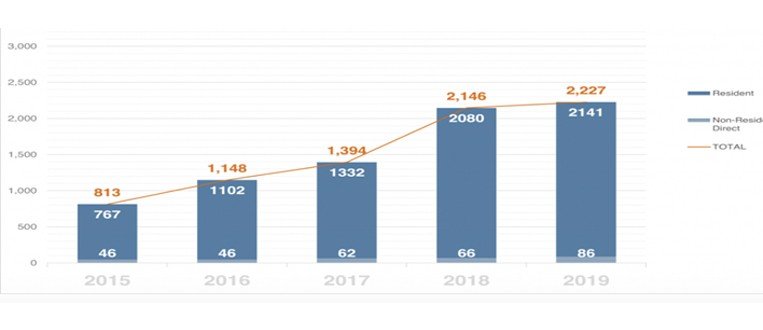Utility Models: Innovation tool for developing economies?
30 April 2021

Domestic invention patent filings in the Philippines, while increasing, have been low as compared to PCT and direct filings by foreigners, and remained at an average of 10 percent of total filings from 2015 to 2019.The unofficial 2020 figures showed a reduction of about 3.5 percent over 2019, which could be attributed to the Covid-19 pandemic. For utility model filings, 96 percent of which come from local or domestic entities, there has been a remarkable surge for the period 2015-2019 of nearly 900 percent as shown in the table below published by the Intellectual Property of the Philippines (IPOPHL):

The unofficial 2020 figures obtained from the IPOPHL showed a marked decline of about 40 percent, which is most likely due to the quarantine protocols implemented by the government to contain Covid-19 infection, by closing or limiting the services of educational and non-essential business entities nationwide. Data from the IPOPHL presented comparatively below revealed that top filers of UM are from state universities and research institutions:
Table 2. Comparative Top UM Filers
2019 |
No. |
% |
2020 |
No. |
% |
Cebu Technological University |
171 |
7% |
Cebu Technological University |
82 |
6% |
Capiz State University |
150 |
6% |
Don Mariano Marcos Memorial |
38 |
3% |
Cebu Normal University |
114 |
4% |
Food Processing Innovation Center (FPIC) Davao |
30 |
2% |
Samar State University |
71 |
3% |
University of Antique |
30 |
2% |
As to the field of technology, the same data shows that food chemistry accounts for over 40 percent of utility model applications:
Table 3. Comparative UM Top Filings by Field of Technology
2019 |
No. |
% |
2020 |
No. |
% |
Food chemistry |
547 |
47% |
Food chemistry |
344 |
39% |
Basic materials chemistry |
79 |
7% |
Furniture, games |
43 |
5% |
Handling |
66 |
6% |
Pharmaceuticals |
42 |
5% |
Furniture, games |
53 |
5% |
Electrical machinery, apparatus, energy |
39 |
4% |
Pharmaceuticals |
46 |
4% |
Other special machines |
36 |
4% |
Historically, it was difficult to wean-off faculty researchers, and this is still an ongoing process, from the publish-or-perish mind set. The Department of Science and Technology (DOST), however, by 2017 stepped up on its IP awareness, training and commercialization programmes, as well as monetary incentives, to encourage state universities and research institutions to convert their research into patentable inventions.
Why utility models?
Utility models have been in the patent system of the Philippines since 1947 when Republic Act 165, patterned after U.S. patent laws, created an independent patent system, and the Philippine Patent Office (now the IPOPHL). U.S. patent laws do not provide for utility models, but applicable patent laws then were made to apply to utility models, which were considered as “any new model of implements which does not possess the quality of invention, but which is of practical utility” and which may be protected. Republic Act 8293 (IP Code), promulgated in 1998 repealed Republic Act 165 and instituted the registration system for utility models as described below:
Table 4. Utility Model Regime in the Philippines
Subject Matter |
A product such as a machine, a device, an article of manufacture, a composition of matter, a microorganism; a process such as a method of use, a method of manufacturing, a non-biological process, a microbiological process; computer related inventions; and improvements thereof (Rule 200) |
Criteria for Protection |
Novelty and industrial applicability. Inventive step not required. Provisions on novelty, non-patentable inventions and industrial applicability for invention patents are applicable to utility models. |
Term of Protection |
7 years without possibility of renewal. |
Examination |
No substantive examination; only formality examination. |
Conversion to Invention |
Once, at any time before the grant or refusal of a utility model. |
Faster issuance of grants, less expense, ease of enforcement against infringers, protection of incremental or minor improvements, or inventions that are perceived to be more susceptible to obsolescence, are the advantages of a utility model. It takes about six to 12 months from filing for the utility model for the certificate of registration to be issued. Official fees are lower, although professional fees of patent agents may not be significantly lower because the utility model to be filed must be strong enough to withstand challenges of lack of novelty, or if the inventor/applicant has plans of filing the utility model as an invention in other countries thru the PCT where inventive step is required, then the application must fulfill said criteria.
Successful UM

The lagundi plant (vitex negundo L.) has been an active composition of 19registered utility models in the Philippines since 2003, e.g., cough andcold medication, herbal tea, liniment oil, dietary supplement, foodsupplement, herbal candy, water colour formulation, etc. Itsdevelopment and commercialization as a natural source of herbalmedicine was supported by the DOST that secured protection for the herbal pharmaceutical composition by way of a utility model obtained in 2001, paving the way for licensing said technology, and fulfilling its mandate to offer more affordable drugs thru locally developed herbal medicine. The Philippine Food and Drug Administration (FDA) approved in August 2020 the clinical trials for lagundi as a mode of adjuvant therapy. The DOST has stated that the pharmacologic properties of lagundi makes it a good candidate in providing symptomatic relief for mild Covid-19 without co-morbidities.
Looking ahead
The Philippines enacted the Innovation Act (RA 11293) on April 17, 2019, and its Implementing Rules and Regulations (IRR) took effect on February 7, 2020. This act aims to improve the position of the micro, small and medium-size enterprises (MSME) in the innovation system. MSME’s comprise about 99.5 percent of the business establishments in the Philippines, contributing about 55 percent of the country’s GDP. Moreover, the act aims to strengthen the public and private partnerships which could lead to more spin-offs, start-up and licensing of the inventions and utility models being generated by state universities and colleges and research institutions.
The IPOPHL has recommended the amendment of the IP Code, and one of the amendments allows the parallel applications of for a utility model and an invention patent, similar to the practice in Germany. Should the utility model application be granted registration, a certificate shall be issued, and the invention application shall proceed independently unless withdrawn. If the invention application is granted, the letters patent will be issued but the utility model registration should be surrendered unless the holder chooses utility model registration. Hopefully, the amendments will be approved by the 18th Congress, which ends in 2022.










